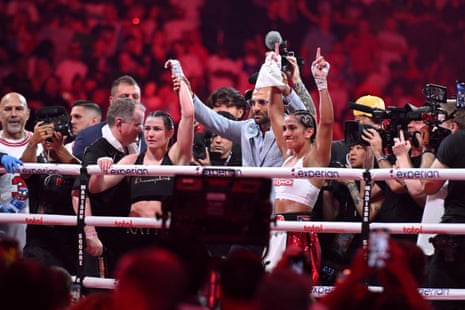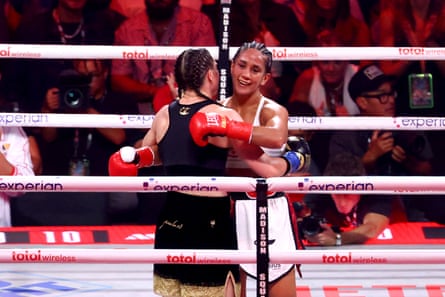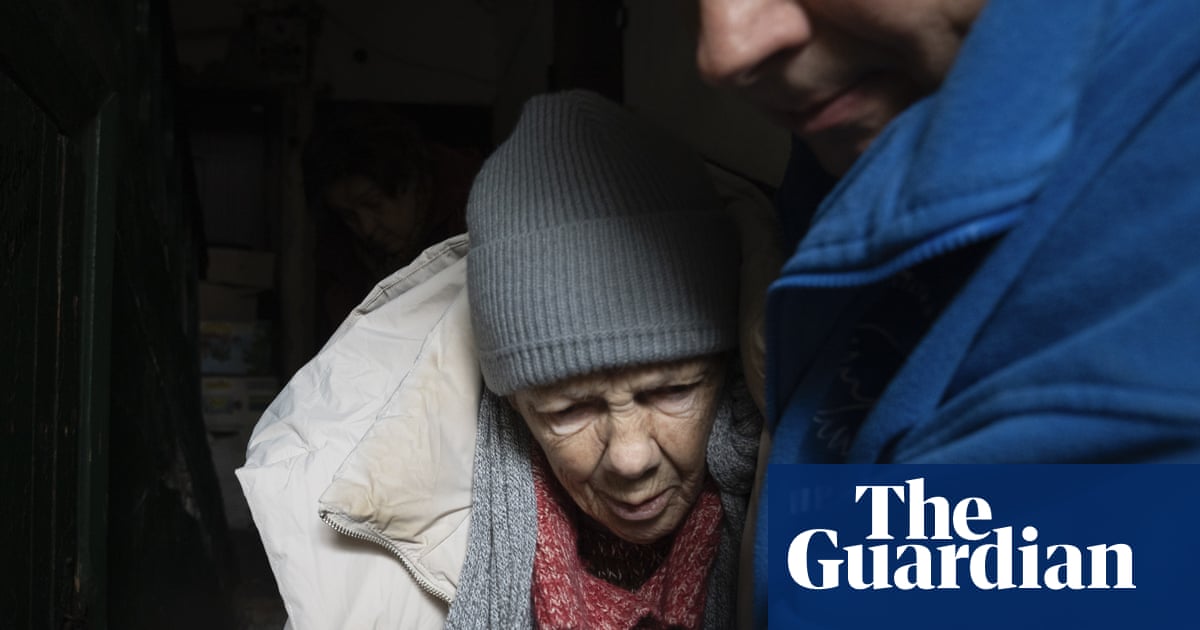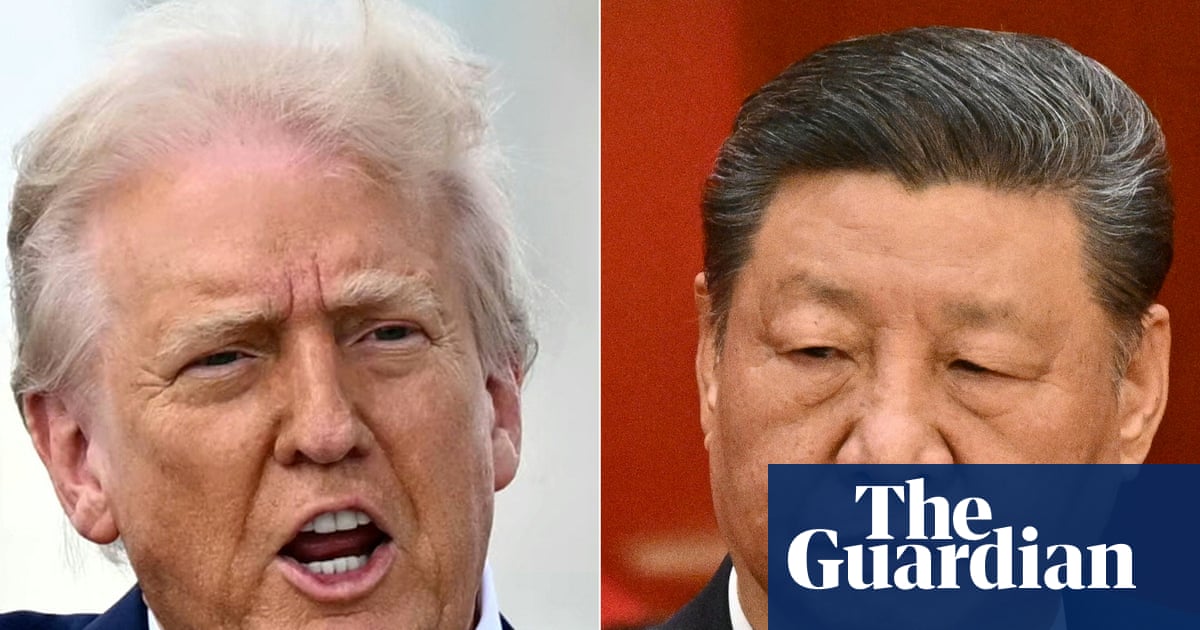There are two salient pictures of the Katie Taylor–Amanda Serrano trilogy: Taylor walking to the ring on Friday night under the green, orange and white bars of light, her neck like a tree trunk, eyes fixed ahead with stoic grandeur as Even Though I Walk played overhead – and the image, hours earlier, of Yulihan Luna bloodied and bruised, standing beside a ring girl whose hoisted breasts had been shellacked in oil, smiling rigidly at a camera that wasn’t looking at the fighter.
That’s boxing. That’s also being a woman.
At Madison Square Garden – half cathedral, half Thunderdome – Katie Taylor approached the ring like a martyr. Her arms stayed low and still, her expression stony, the moment at once subdued and transcendent. I am not religious. I was personally rooting for Serrano. But when I heard that worship music and saw Taylor ascend and bow between the ropes, I seemed to see stars as tears blurred the lights of the Garden’s lofted ceiling into a constellation: The Fighter.
A spectacle like this ought to be mawkish. But it isn’t. Because when the song ends, two women risk their legacies, their health, their lives – however unlikely – to feel something like greatness. And unlike most sports, in boxing, the risk is not metaphorical. The danger is useless. It protects no country. No one is conscripted. But it underwrites everything that feels noble about this violent, anachronistic art. And when women, historically deemed too fragile to fight, headline an iconic arena that has never before granted them that right, the danger takes on a new meaning.

They say styles make fights. They also make stories. Taylor, the pride of Ireland, is all monkish discipline and point-winning speed. Serrano, the southpaw from Puerto Rico by way of Brooklyn, combines firepower with grit. One boxed her way through 15 years of amateur pedigree, the other turned pro at 19 and never looked back. Both are in their mid-30s, both single, both quiet. Sainted recluses with 17 world titles between them and a lifetime of sacrifice.
If Taylor is the tactician, Serrano is the flamethrower. This polarization is what produced lightning in the first two fights. But by Friday night, their plans of attack had changed. Serrano, seeking alternatives after two contentious decisions that didn’t go her way, tried to outbox the boxer. Taylor, burned before in brawls, circled and struck, then slipped away. From round one, it was clear: this was no longer a firestorm. The fight bore more resemblance to Mayweather-Pacquiao than Ali-Frazier I. Smart. Tactical. Controlled. For some, disappointing.
But why do we need chaos to believe in a woman’s greatness?
In other sports, I root for my team to win, ugly or not. But in women’s boxing, I confess to a double standard: I want glory and a good show. I want drama, blood, something irrefutable. That fear – that if women don’t entertain, the sport will vanish – lingers like smoke above the ring. But Taylor and Serrano were not performing for our approval. They were fighting to win.
This, in itself, is progress.

True equality in boxing is not the right to inspire. It’s the right to be boring. To clinch and move. To fight safe. To win ugly. Taylor-Serrano III wasn’t transcendent because it was thrilling. It was transcendent because it didn’t have to be.
And yet boxing remains a sport of contradictions. To protect yourself, you must risk everything. To gain glory, you court death. And still – some would deny women the choice to do so.
When Amanda Serrano and more than a dozen elite fighters issued a joint call last year for 12 three-minute rounds – the same as men – they framed it not as a demand, but as a right: “We have earned the CHOICE,” they said.
The irony is that boxing is one of the only spaces in Western society where a woman can risk her life and be compensated. But even then, OnlyFans logos hover over ring posts and girls in bikinis parade cards while bloodied fighters wait for judgment. Fans call the athletes they flew across oceans to support “autistic lesbians”. Serrano gets seven figures. Some women on the undercard get $1,500 and no health insurance – turning, more ironic still, to OnlyFans for financial security.

What do we mean when we talk about choice?
We fight for a woman’s right to have a child – or not. But what about the right to bleed for nothing more than self-belief? What about the right to hurt for glory, not survival? Women are told their bodies are sacred, but only in service of others – children, husbands, God. In boxing, they reclaim them. Not for nurture, but for risk. Not for life, but for something more defiant. Not Madonna. Not whore. Something else.
Katie Taylor and Amanda Serrano did not ask for sainthood. They asked for a trilogy. They made history, then made it again, then closed the book.
Now, whether Friday night becomes a watershed or a footnote is not up to them.
But for those of us watching, feeling the hush before the bell, the flutter of green, orange, red and blue fabric, the rush when Taylor’s glove was raised and an Irish flag drifted gently down from the upper seats – whether Catholic or atheist, Irish or Puerto Rican, man, woman, or something in between – these two ensured one thing:
Watching them time after time after finally time again will do something more than impress you.
It will resolve contradictions – between styles, between images of a fight, between even life and death – into a single indelible reckoning.

 3 months ago
43
3 months ago
43

















































